Belize’s world-class dive sites of Lighthouse Reef Atoll are just minutes from Long Caye! Dives include the world-famous Great Blue Hole, Half Moon Caye, the Aquarium, Que Brada, Silver Caves, and the Cathedral.
We have a fully equipped Dive Shop at the Resort. Save the travel weight – we can outfit you on the Caye. Let us know if you are interested and we can offer NITROX dives too.
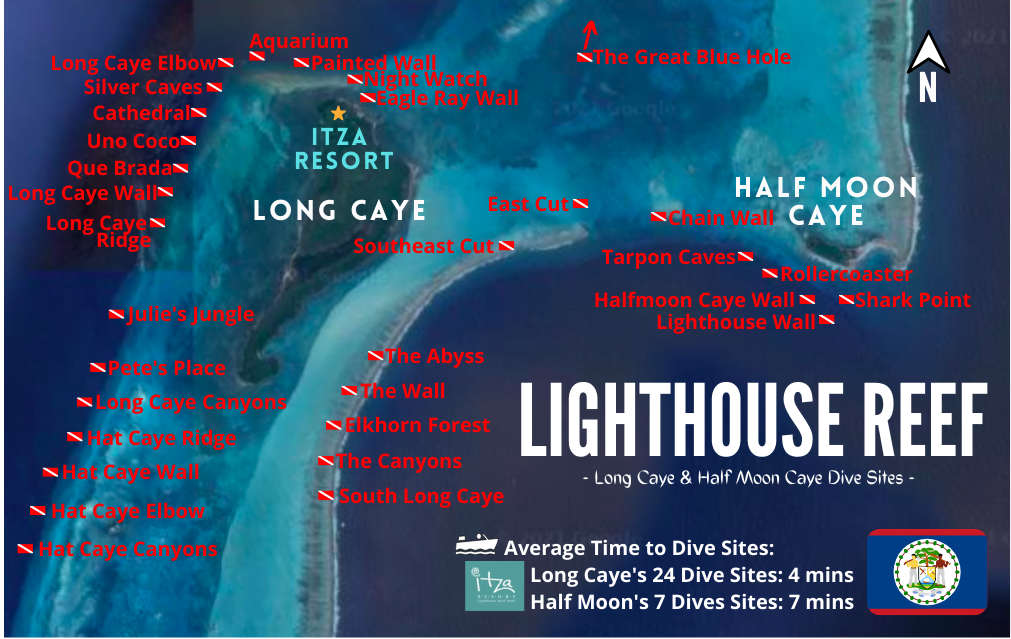
Warm waters, calm conditions and 50- to 100-foot vis draws thousands of divers from across the world to this corner of Belize, but because you’re staying right in the heart of the atoll, you often get the sites all to yourself. Itza’s boat is the first one out in the morning to many spots, including the famous Great Blue Hole, which is only 15 minutes away. That’s one of the best things about Itza: The best diving in Belize is only a short boat ride away — so short, in fact, that you return to the resort for each surface interval.
The Lighthouse Reef Atoll, approximately 50 miles east off the coast of Belize City, is one of only four atolls in the Western hemisphere. Equivalent to a large saltwater lake surrounded by a ring of coral in the middle of the Caribbean, the Lighthouse Reef Atoll is 27 miles in length and about eight miles wide.
With its unique variety of marine life in such an untouched state, Lighthouse Reef Atoll is one of the largest and most impressive examples of an atoll coral reef ecosystem. Scuba diving here attracts people from all over the world.
They come to dive into this magnificent underwater paradise and explore its magnificent marine ecosystem that extends for miles. Within the atoll and a few minutes away from Itza Resort are two UNESCO World Heritage sites, Half Moon Caye Bird Sanctuary and Belize’s most famous diving spot, the Great Blue Hole.
With such a wide variety of dive sites in the area, it can be hard to narrow down where to spend your dive time. To make it easy, leave the site choice up to Itza’s knowledgeable divemasters. Simply tell them what you want — walls, drop-offs, drifts, reefs, you name it — and they’ll pick the perfect site to suit your desires, ensuring that no matter your skill level or experience, your dives will be enjoyable. Don’t forget to schedule a night dive to see Belize’s incredible underwater world after the sunsets.
Join our PADI certified Dive Masters and instructors. You should plan for 2 – 3 dives daily at 08:00 am, 10:30 am and 2:00. If you’re interested in a little adventure, enjoy a night dive around 6:00 pm when scheduled (depending on weather conditions).
Our local dive sites are remote for everyone else. Most of the traffic you will experience will be from Dolphins, Spotted Eagle Rays, Sharks, Turtles, Groupers, Tarpons, Octopus, Sea Slugs, Shrimps, any many more fish and creatures – just keep in mind: the ocean is not a zoo but you might see all that and more on one dive.
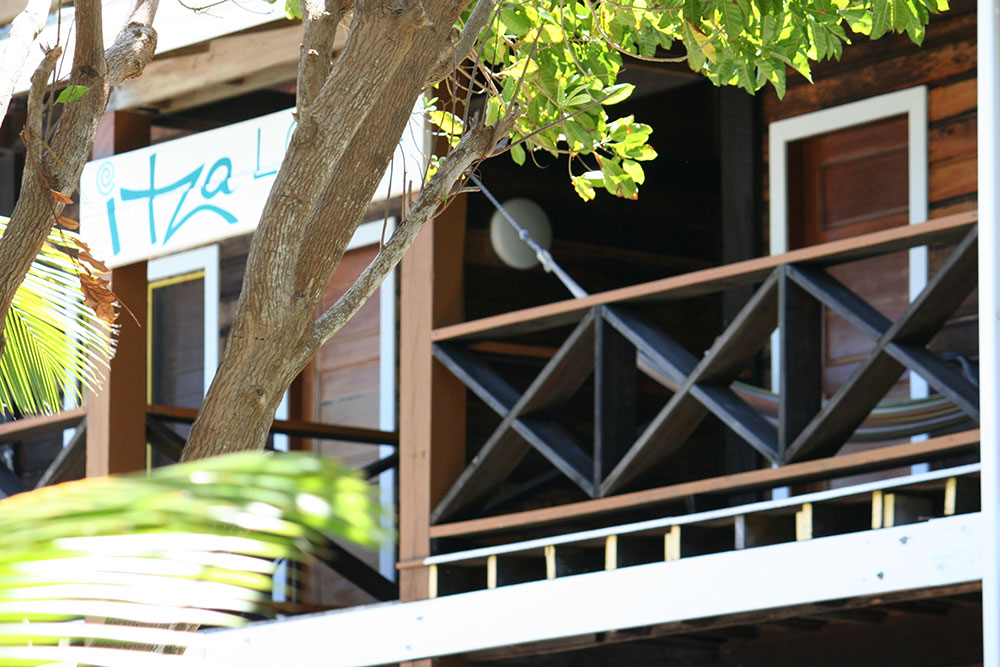
Experience the western hemisphere’s largest barrier reef. Belize is a diver’s paradise, and the Lighthouse Reef Atoll is the best place to dive in Belize. The atolls are the epitome of the Belize diving experience. They are far from shore and are basically wilderness existing in pristine conditions. A wonderful underwater world with beautiful coloured Corals, Sponges, Sea Fans and a huge variety of small and big creatures is awaiting you.
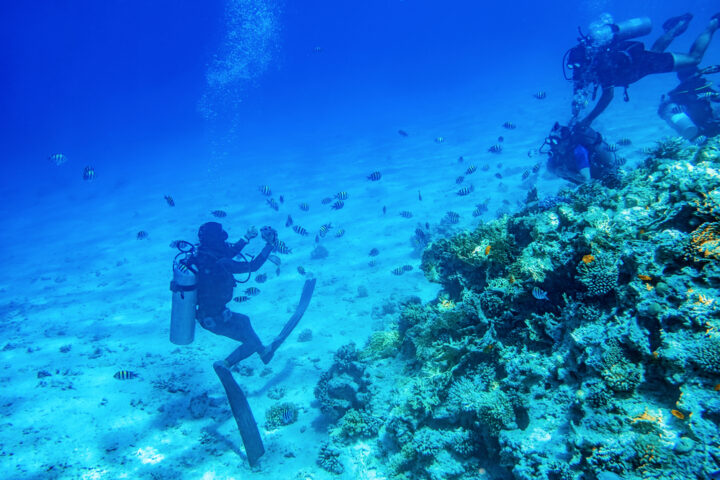
Itza Resort pays special attention and detail to all of our guests. The only thing we ask you to do is please take the time to relax between dives. Between each dive, we return to the resort for all surface intervals so you can recharge and get ready for the next adventure below the surface. Our service on board the boat includes: briefings, drinking water on board, fruit on board for Half Moon dives, divemaster (max 8 divers/divemaster), signing logbook + stamps.
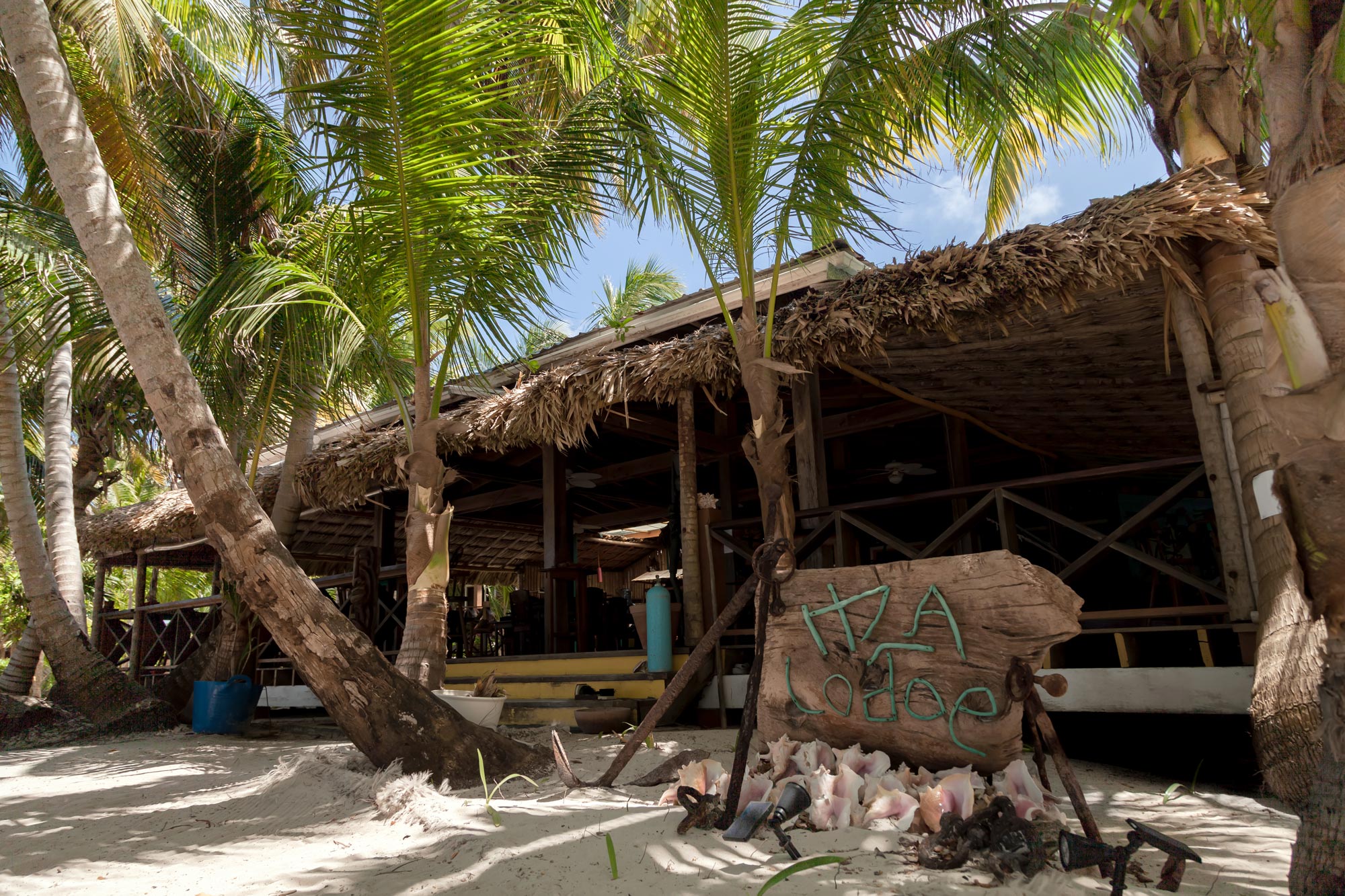
Spend less time on board and more time diving. What takes hours for other resorts to reach is located just minutes from our shores. The dive sites are all located within a few minutes boat ride from the island. We are usually in and out of the Blue Hole before other dive companies arrive for the day…giving our divers an experience of a lifetime! Our close proximity allows our Dive Masters to always choose the best dive site for you regarding weather conditions.

Our Dive Masters and Instructors collectively have more than 7000 logged dives and have certified over 500 Divers. They will take care of you and teach you far beyond the standards of diving. Before your first dive, they will talk with you about your dive experiences and skills. All of them are dedicated divers and Dive Masters whose first priority is always to look out for your safety and happiness. Just a Few of our local World Class Dive Sites

Bring your own wetsuit and equipment OR rental service is available. The equipment rental fee is $45 US/person/day and includes fins, mask, snorkel, BCD, regulator, and wetsuit. Choose your gear rental options when booking your trip to ensure the availability of sizes.
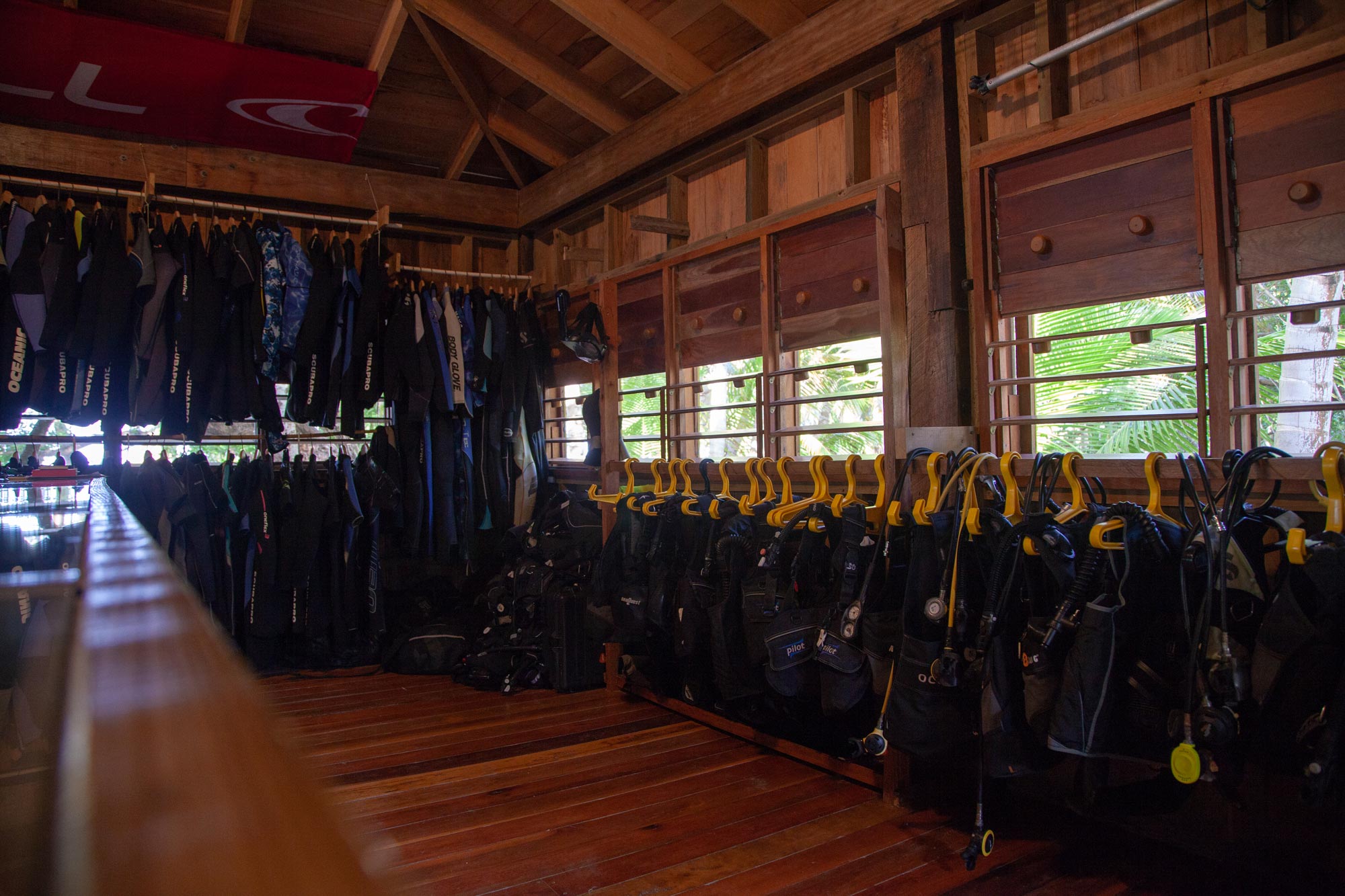
Do you have a Dive Insurance with DAN or another Dive Insurance? Not yet? You can get it online today.
The Blue Hole was just voted “The Best Dive Site in the World” by the readers of Scuba Diver Magazine! Located just eight miles from Long Caye. It was made famous by Jacques Cousteau in his 1970 Calypso journey. In the last ice age, seawater was frozen in glaciers lowering the sea level more than 350 feet, exposing the limestones of the Lighthouse Reef Atoll. As a result, larger subterranean caverns were created when freshwater flowed through the limestone deposits. Since this ice age, the top of the cavern has collapsed to form this sinkhole. With 100 feet of visibility, there are no currents and there are depths of over 400 feet making the Blue Hole an amazing site for advanced level divers.
The Blue Hole is a round, deep depression in the center of more than 75 square miles of blue-green water, making up the Lighthouse Reef Atoll. Its diameter is just over 1,000 feet, with a maximum depth of just over 400 feet. Besides two narrow passages on the eastern and northern rims, the Blue Hole is entirely surrounded by living coral.
Visitors may dive either the north or south side to depths of 100 to 150 feet where the closest caves may be seen. You can begin by snorkeling to the coral rim. A good way to keep your sense of direction while you are descending in the Blue Hole is to not get too far from the wall. There is an overhang that shapes a cave-like ceiling that stalactites hang with a width of more than three feet and up to 20 feet in length. As you descend below the ceiling, the bottom of the cave has numerous detached stalactites. Occasionally you may see a shark or turtle casually swimming by.
Red algae, hydroids, and gorgonians cover most of the corals. You may also find sharing brush, mermaid’s fan algae, elkhorn, club finger, shallow-water starlet corals, giant green anemones and various urchins. The most diverse and abundant marine life is found on the reefs that border the outside of the Blue Hole. Snorkelers will also enjoy observing the many life forms that surround the Blue Hole.
The coral ridges here have many holes and grottos, providing a sanctuary for a variety of marine life. The Aquarium is breathtaking for intermediate level divers with depths of 30 plus feet, visibility of 80 feet with the possibility of currents. Moderate to strong currents flow across the reef here almost all the time.
When exploring the north-facing wall of the point, you may find moderate currents too. These currents by the point usually go across the reef from the east. To feel less of the current, you should go down to the reef surface. If you swim east at the beginning of the dive, you will have an easier trip back to the boat. Named for its wide-ranging marine life, the Aquarium is where you will see the ordinary and extraordinary.
Many of the animals that are usually hidden deep in the reef at other dive sites are more visible at the Aquarium. A good place to check is next to the crest of the wall. By the top 50 feet of the wall, deep-water lace coral and black coral are also seen. All different types of parrotfish can be seen on the algae patches covering the reef top. The fish are definitely colorful and diverse at the Aquarium.
The Aquarium (long Caye Wall) is located right off the northwestern side of Long Caye. Clear, long coral ridges and sandy canyons run perpendicular to the reef.
The coral ridges here have many holes and grottos, providing a sanctuary for a variety of marine life. The Aquarium is breathtaking for intermediate level divers with depths of 30 plus feet, visibility of 80 feet with the possibility of strong currents. Moderate to strong currents flow across the reef here almost all the time. When exploring the north-facing wall of the point, you may find troublesome currents too. These currents by the point usually go across the reef from the east. To feel less of the current, you should go down to the reef surface.
If you swim east at the beginning of the dive, you will have an easier trip back to the boat. Named for its wide-ranging invertebrate life, the Aquarium is where you will see the ordinary and extraordinary. Many of the animals that are usually hidden deep in the reef at other dive sites are more visible at the Aquarium. A good place to check is next to the crest of the wall. By the top 50 feet of the wall, deep-water lace coral and black coral are also seen. All different types of parrotfish can be seen on the algae patches covering the reef top. The fish are definitely colorful and diverse at the Aquarium.
The Blue Hole was just voted “The Best Dive Site in the World” by the readers of Scuba Diver Magazine! Located just eight miles from Long Caye. It was made famous by Jacques Cousteau in his 1970 Calypso journey. In the last ice age, seawater was frozen in glaciers lowering the sea level more than 350 feet, exposing the limestones of the Lighthouse Reef Atoll.
As a result larger subterranean caverns were created when fresh water flowed through the limestone deposits. Since this ice age, the top of the cavern has collapsed to form this sinkhole. With 100 feet of visibility, there are no currents and there are depths of over 400 feet making the Blue Hole an amazing site for advanced level divers. The Blue Hole is a round, deep depression in the center of more than 75 square miles of blue-green water, making up the Lighthouse Reef Atoll. Its diameter is just over 1,000 feet, with a maximum depth just over 400 feet. Besides two narrow passages on the eastern and northern rims, the Blue Hole is entirely surrounded by living coral. Visitors may dive either the north or south side to depths of 100 to 150 feet where the closest caves may be seen.
You can begin by snorkeling to the coral rim. A good way to keep your sense of direction while you are descending in the Blue Hole is to not get to far from the wall. There is an overhang that shapes a cave-like ceiling that stalactites hang with a width of more than three feet and up to 20 feet in length. As you descend below the ceiling, the bottom of the cave has numerous detached stalactites. Occasionally you may see a shark or turtle casually swimming by. Red algae, hydroids and gorgonians cover most of the corals.
You may also find sharing brush, mermaid’s fan algae, elkhorm, club finger, shallow-water starlet corals, giant green anemones and arious urchins. The most diverse and abundant marine life is found on the reefs that border the outside of the Blue Hole. Snorkelers will also enjoy observing the many life forms that surround the Blue Hole.
Tres Cocos was named from a group of three tall coconut palm trees just east on Long Caye. This spot is about one mile north of the Hat Caye Drop-off. It is another marvelous dive site on the western side of the Lighthouse Reef Atoll, right next to Long Caye.
It has a shallow coral reef and wall with big overhangs. With visibility of about 80 feet and depths starting at 30 feet with minimal to medium currents, makes this a great site for beginners also. While algae covers a lot of the shallow reef, there is plenty of other marine life to see. Coral shrimp, large spotted moray eels, lion’s paw sea cucumbers, urchins, arrow crabs and sea feathers are also found at Tres Cocos. There are many parrotfish, damselfish and blue tang there for the algae and in the water above you will see many jacks and large black groupers.
You may also see turtles, Spanish mackerels, Creole and Black coral on the wall. Further north on the wall, you will see large sand flats that replace the reef and a wall with gorgeous coral arches below the surface. Rays, Conch and peacock flounders can be seen here. Hanging from the wall and arches are tube sponges and soft corals.
Close to Long Caye is an island called Hat Caye, where there is a reef drop-off, which is where it got its name. It is found along the central wall in the western part of Lighthouse Reef and it has an alluring shallow reef and is the southernmost site divers regularly go to in the atoll.
There is a wide shallow reef, with a wide patch of sloping sand separating two reefs. One is very shallow close to the island and the other is a narrow line that is on top of a drop-off. Dive boats usually anchor above the sloping sand areas near the wall, which provides a great dive with dramatic wide-angle picture opportunities. Also check out the sandy slope behind the reef against the wall. The visibility on this site is about 50 feet, with minimal currents, making this a good site for beginners. Right at the perimeter of Hat Caye Drop-off there are massive basket sponges. Many divers try to climb into the basket sponge’s opening, but sponges take a long time to grow, and usually get damaged when divers do so.
Damaged sponge tissue is vulnerable to disease, which eventually destroys the sponge. These sponges are also home to many other marine animals. A plethora of starfish may be seen. Also look for coral shrimp with their white antennas. Giant yellow tube sponges and deep-water lace coral, as well as many fish may also be seen at the Hat Caye Drop-off.
Unlike other parts of the Long Caye reef system, those at Cathedral are profoundly segmented. The Cathedral Reef starts shallow with the wall cresting at 30 feet. Sculptured by and rising above the sand channels are coral formations, which is how it got the name Cathedral.
The Cathedral’s depths are 30 feet plus, with 50 feet visibility and a light current making it great for the intermediate skill level diver. Divers can see narrow passages and tunnels along with some fascinating and diverse marine life. Coral gardens decorate the reef top and sponges color parts of the coral stacks red and orange. There is also cactus coral to be seen and photographed. The many and varied fish at this site are also an attraction.
There are groupers, French angels, stoplight parrots, trumpets and yellowtail snappers. Past the reef, large sheet coral up to six feet across cover the wall with huge basket, rope and long yellow tube sponges. Wire coral, deepwater lace and other soft coral growths extend up to five feet. You will also find turtles, lobsters, eagle rays and groupers.
Half Moon Wall is an amazing dive spot, which includes the Half Moon Caye National Monument. Before or after your dive you can also see the boobie bird sanctuary on Half Moon Caye.
The reefs here are magnificent and diverse. The site is located just south of Half Moon Caye. The coral structures form a thin rim at the border of the wall. There is also a sloping, desolate sand flat separating the reef rim from shallow reefs by the shore. The Half Moon Wall is an excellent dive spot for the intermediate level diver. It has depths of 30 plus feet, amazing 100 feet of visibility and low-level currents. When divers go 30 feet below, they see that the reef rim has a stunning development of spurs and grooves.
There is both large and small marine life on the Half Moon Wall. You will see garden eels, conch, rays, flounder, star-eye hermit crab, tilefish, manta rays, groupers, yellowtail snappers, razorfish, toadfish, spotted eagle rays, turtles and black groupers as well as various other marine creatures at the Half Moon Wall.
Another grand dive site. Just a ½ mile north of the Long Caye Ridge you will see Que Brada or “broken reef.” It has a fine ridge of corals rims and crescent-shaped wall. As on other parts off the west side of Long Caye, the wall is vertical to slightly overhanging.
You will see plentiful stacks of coral sprinkled across the sandy bottom. The coral patches extend right up the wall, and just north, turns suddenly to the east. It depth range is 40 plus feet, 80 feet of visibility and having minimal currents making it another great spot for new divers. Like elsewhere off Long Caye, coral and sponge growth provide plenty of great photography subjects, with some of the best being the fish. Many dive boats have been feeding fish here for years. Schools of yellowtail snappers shadow divers on the reefs. Large black groupers, ocean triggerfish, spotted eagle rays and turtles can be seen at this site, allowing for spectacular photos.
Eagle Ray Wall is located on the other side of a tidal cut through the north end of Long Caye and near Nurse Shark Lodge. Most of the time you can see eagle rays right off the wall. They are regularly seen about 40 feet below the surface. Great for snorkeling, this spot has an outstanding shallow reef and a colorful wall.
The reef is not more than 35 to 40 feet and there are several long coral ridges separated by sand gullies, where snorkelers can follow these formations into shallow water and can go right to the reef crest, while divers are directed to the opposite. The wall drops considerably into the deep along this part of the reef, where it is full of corals and red cup sponges. This wall is also loaded with an assortment of fish and invertebrates.
Also for intermediate level divers, it has depths of 35 plus feet, 80 feet of visibility and low currents. In addition to the eagle rays, there are many beautiful underwater highlights.
The Long Caye Ridge is located on the western side of Long Caye. It is named from a ridge of reefs sticking out that form a small peninsula just north of Tres Cocos. Spur-and-groove formations can be found on the bottom leading to the wall and a drop-off of major proportions.
The grooves are perpendicular to the wall and go directly into the sea. With depths of 40 plus feet, 80 feet of visibility and minimal currents, the Long Caye Ridge is excellent for beginners. The sponges, coral and fish here are similar to those on Hat Caye Drop-off. There are many large and colorful sponges and delicate gorgonians near the drop-off and all along the wall. Below the soft coral, vase and tube sponges there are developments of finger and yellow pencil corals. You will also see coral niches for spotted crabs, lobsters, filefish and arrow blennies. This is also a great site for underwater photos.
This site was named from the large schools of silversides that were usually found inside the caves. The coral development sets this site apart from all the others. Massive coral formations create a structure full of cavities for marine animals to hide in. Another spot for intermediate divers, with depths of 40 plus feet, visibility of 80 feet with none to light current conditions.
Several nocturnal animals, such as sea urchins and brittle starfish can be seen at this dive site during the day. The sides and ceilings have red and orange sponges and mosses. Along the surfaces you may see basket starfish and unusual sponges in the shallow areas.
Some divers have seen sclerosponges. They were thought to be extinct and were rediscovered within the last 20 years. These sponges are known to be located in caves in shallow water and help build reefs below 150 feet. They are rare, but can be seen at Silver Caves.
| PADI Courses | ||
|---|---|---|
| Discover Scuba | $195.00 | |
| Refresher / Skill-Up | $85.00 | |
| SCUBA Diver Course | $500.00 | 2 Dives included |
| Open Water | $650.00 | Including 4 dives |
| SSI Open Water E-Learning | $550.00 | Including 4 dives |
| Universal Referral Open Water | $400.00 | Including 4 dives |
| Advanced Open Water | $540.00 | Including 5 dives |
| SSI Advanced E-Learning | $450.00 | Including 5 dives |
| Rescue Diver* | $800.00 | |
| SSI Rescue Diver E-Learning | $650.00 | |
| NOTE: ALL Charges are subject to 12.5% General sales tax (GST) |
| Gears & Equipment Rental | Per Person | |
|---|---|---|
| Full Snorkel Equipment Rental (mask, snorkel, fins) | $25.00USD | per day |
| Full Dive Equipment Rental (snorkel gear, wetsuits, bcd, regulator) | $45.00USD | per day |
| Full Dive Equip. Rental w/computer | $55.00USD | per day |
| Rented Individually | ||
| Dive Computer | $20.00USD | per day |
| BCD | $20.00USD | per day |
| Regulator | $20.00USD | per day |
| Wetsuit | $15.00USD | per day |
| Fins | $15.00USD | per day |
| Mask & Snorkel | $15.00USD | per day |
| NOTE: ALL Charges are subject to 12.5% General sales tax (GST) |
| Park Fee | ||
|---|---|---|
| Belize Blue Hole | $30 | per person |
| Halfmoon Caye | $10 | per person |
| Piloting | $350 | per hour |
| Private Guide | $250 | per hour |
All prices in US $, All courses, dives and snorkels include transportation, briefing, dive master or snorkel guide, water and snacks on board the boat, weights and tanks, All are exclusive of marine park fees and sales taxes.
Park Fees US $30.00/pp for Blue Hole & US $10.00/pp for Half Moon Caye are not included and are payable directly to Park Rangers on site.
*course materials included
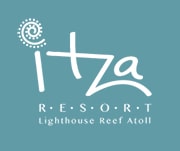
Copyright © 2024 Itza Resort – Long Caye, Lighthouse Reef Atoll -:- www.itzaresort.com – Belize Dive Resort -:- Sitemap